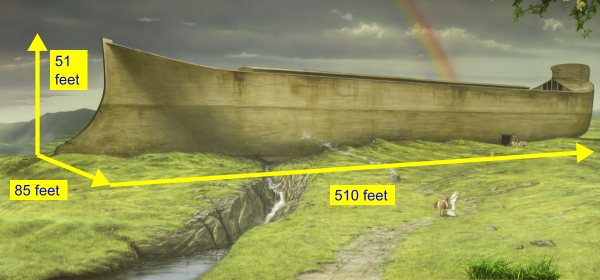Isn’t Noah’s Ark a box shape? After all, the dimensions are given as length, width, and height. Any comments?
–J. and D.
Dear J. and D.,
Thank you for contacting Answers in Genesis regarding the shape of Noah’s Ark. First of all, I’m glad that you are looking into this topic. It shows your desire to be biblically accurate, and I want to commend you for this as Luke commended the Bereans (Acts 17:10–11).
Now, I want to encourage you to dive into the subject in even greater detail. Note that our Ark (The Lovett Design) is in accordance with the biblical description. The dimensions given in Genesis 6:15 are 300 x 50 x 30 cubits, which translate on the long or royal cubit as roughly 510 x 85 x 51 feet (see the picture below). Some argue for a box shape while others argue for something that looked more like a ship. The basis for this comes from the scant information given in Genesis:
“Make yourself an ark of gopherwood; make rooms in the ark, and cover it inside and outside with pitch. And this is how you shall make it: The length of the ark shall be three hundred cubits, its width fifty cubits, and its height thirty cubits. You shall make a window for the ark, and you shall finish it to a cubit from above; and set the door of the ark in its side. You shall make it with lower, second, and third decks.” (Genesis 6:14–16)
Keep in mind that the Bible doesn’t say it was a box shape. A box-shape is assumed by taking the length, width, and height of the Ark and merely making it into a box. However, this was likely not the case, as ship dimensions are typically given as length, width, and height. This is common for other things as well. For example, a Corvette ZR1’s dimensions are given as the following:
Overall length (in / mm): 176.2 / 4476
Overall width (in / mm): 75.9 / 1928
Overall height (in / mm): 49 / 1244
Are we to assume the Corvette is a box shape given only its length, width, and height? Not at all. Noah’s Ark was a ship; therefore, it likely had features that ships would commonly have. These are not at all unreasonable assumptions. Noah was 500–600 years old and knew better than to make a simple box that would have had significant issues in a global Flood (e.g., forces on the sharp corners would be too destructive, it could capsize if it is not facing into the wind and waves, and so on). The common way that a floating boat would keep from being turned perpendicular with the wind and waves is by having features on the front and back that naturally point it into the wind and waves. This would eliminate the need for four sharp corners as well.
The word for Ark in Hebrew is תֵּבָה (tebah), which is also the word for the bulrush basket in which Moses was laid as a child and then placed in the Nile (Exodus 2:3). Furthermore, tebah is not the same word used for the Ark of the Testimony or Ark of the Covenant—that Hebrew word is אְַרִוֹן (’arown).
The word tebah in some modern lexicons yield the definition of box, but is more properly chest and related to the Egyptian word for coffin. I’m sure that being in the Ark for nearly a year must have felt like being in a coffin. Recognized Hebrew lexicons such as Brown, Driver, and Briggs, yield the meaning of tebah regarding Noah’s Ark and the basket of Moses as a vessel, not a box.1, 2
I want to encourage you to read these two articles carefully with your Bible in hand so that you may understand all the research that went into the shape and design of our depiction of Noah’s Ark and why it would more than likely have included features of a ship:
- http://www.answersingenesis.org/articles/am/v2/n2/depicting-the-ark
- http://www.answersingenesis.org/articles/am/v2/n2/thinking-outside-the-box

I pray that this helps to clarify matters. God bless,
Bodie Hodge
Footnotes
- The Brown Driver and Brigg Hebrew and English Lexicon, Hendrickson Publishers, Peabody Massachusetts, Ninth Printing, September 2005, page 1061.
- Here’s a fun fact. “Moses baskets” have become a novelty in certain places today and they are not a box shape either, but rather rounded. Their dimensions are commonly 30 in. x 12 in. x 9 in. Of course, since the Bible does not provide the dimensions of the ark in which Moses was placed we cannot state with any certainty what the size may have been.